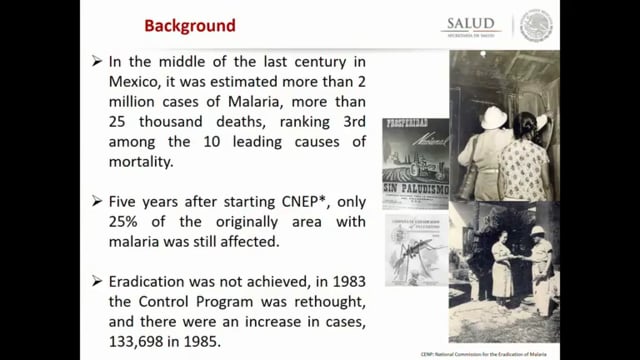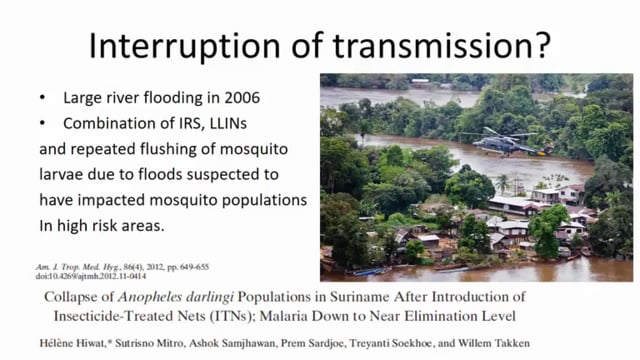ASTMH 2018: Session 178 “Integrated Vector Management in Malaria Elimination Settings: Charting the Way forward in the Americas”
Published: 18/12/2018
THEMES: THEMES: Health Systems | Vector Control
MESA Correspondents bring you cutting-edge coverage from the 67th ASTMH Annual Meeting
Session 178: “Integrated Vector Management in Malaria Elimination Settings: Charting the Way forward in the Americas“
Integrated Vector Management (IVM) is one of the malaria control strategies required to sustain the gains achieved towards regional, subnational and national elimination. This symposium aimed to highlight and discuss aspects of vector control in the Americas.
Roberto Montoya (Pan American Health Organization): The Epidemiology and Challenges for Malaria Elimination in the Americas: The regional overview, PAHO epi overview
This session started with a regional overview of malaria epidemiology and vector-related issues and analysis of some of the causes of reversal of recent gains. Latest updates on malaria morbidity and mortality in the Americas from 2007 to 2017 show that the number of confirmed cases was falling until 2014, with a resurgence in 2015. By 2017, even though the number of deaths was apparently reduced, the number of confirmed cases rose, possibly related to increases in several countries including Nicaragua, Venezuela, French Guinea, Belize, Brazil (Amazonian Region), Mexico, Guyana, Ecuador, Bolivia and Costa Rica. The Annual Parasitic Incidence (API), was observed to be higher than 30-50% in areas such as Grand’Anse and Sud in Haiti, Mosquitia in Honduras-Nicaragua, Bolivar in Venezuela, Chocó in Colombia, the Amazonian Region in Brazil, and Loreto in Perú. In 2017, 77% of malaria total cases in the Americas were found in Venezuela (53%) and Brazil (24%) alone. Of this burden, one third was located in five districts of Venezuela (being the ones with the most cases Sifontes 18%, El Callao 5% and Atures in the Amazonas 6%).
P. vivax dominates the clinical picture with more than 70% of malaria cases caused by this species and out of 19 malaria endemic countries, 6 had exclusively P. vivax transmission. By contrast, the transmission in Haiti and the Dominican Republic was exclusively due to P. falciparum.
Some of the major reasons that seem to be related to the recent increases of malaria in the Americas are:
- in Loreto (Peru), there has been an increase in the number of cases as a result of the challenge of moving from external funding supported by the Global Fund for AIDS, TB, and Malaria to national funding;
- fast housing development without appropriate urban planning for health and other services; or
- internal crisis (Venezuela).
Some of the challenges for better progress on the road to elimination include:
- Inadequate access to appropriate diagnosis and treatment;
- Reduced perception of risk in populations living in areas close to elimination;
- Support for passive detection of cases in remote and mobile populations including migrants;
- Vector control coverage and surveillance: even though IRS coverage is favourable, there are signs of insecticide resistance in most of the countries (Guatemala, El Salvador, Honduras, Costa Rica, Colombia, Brazil and Bolivia). This challenge may require the introduction of new insecticides.
- Another challenge is the lack of financial resources: even countries with higher GDP invest amounts similar to those of poorer countries. Inadequately funded National Malaria Control Programmes often depend on other national funding sources and on Vector Control Programmes that may direct resources towards urgent problems such as Dengue.
- Additional technical challenges are:
- HRP-2 deletion in P. falciparum isolates: HRP-2 negative P. falciparum was detected in highly endemic areas in South America in 2010 and recently detected in Central America.
- Low sensitivity of the pLDH component for P. falciparum in the current HRP2/pLDH RDTs.
- Varied vector behaviour: An. albimanus biting habits are changing with 50% biting seen to be indoor in Dajabón, Dominican Republic and only 33% in Puerto Lempira, Honduras.
- Relapses of P. vivax, the main parasitic species. Treatment requires adherence to a 14-day primaquine treatment regimen after GDP6-deficiency testing that would also be required with the future introduction of tafenoquine.
Achievement of malaria-free certification of Paraguay in June 2018 was a major milestone and Argentina is proceeding with the same process. El Salvador has reported zero endemic cases since November 2016 (ongoing second year); Costa Rica reported zero endemic cases for two years and 10 months (2013-2015); Belize has reported fewer than 10 endemic cases since 2015; and Bolivia reported zero P. falciparum cases for two years (2016-2017).
Gustavo Sanchez (National Center for Preventive Programs and Disease Control, Mexico): The Epidemiology and Challenges for Malaria Elimination in the Americas: A country overview
In Mexico, even though there has been great success with malaria reduction, South and North regions are still problematic, mainly because they are migration areas that hinder approaches to outbreak control. From 29 affected states in 1990, transmission was reduced to only 7 states in 2017, the most prevalent species being An. pseudopunctipennis, An. albimanus and An. vestitipenis. Malaria was eliminated as a cause of death in the country between 2000 and 2015 and transmission was reduced from 7390 cases to 517. P. falciparum local transmission of severe malaria was eliminated in 2009, with 24 states free of endemic transmission in 2015. These successes relate to diagnosis and appropriate treatment for confirmed cases and strengthening the link between epidemiological surveillance, vectors, laboratory, and health promotion.
The current situation in the country is as follows: Chiapas and Chihuahua have had malaria outbreaks since 2016, and these regions still record more than 90% of the transmission of the country. Oaxaca, Jalisco and Sonora are not reporting cases even though Oaxaca was reported to have the second highest transmission rates in the country some years ago. Tabasco, Nayarit, Sinaloa and Durango are moving forward towards elimination with most cases related to movements of migrants.
Helene Hiwat-Van Laar (National Malaria Control Program in Suriname): Vector control strategies in an elimination context: The example of Suriname
In Suriname, decision-making and vector control strategies have been guided by changes in the risk of transmission. Since 2005, following increased investments in prevention and control, malaria transmission decreased towards elimination. Since 2009, mobile migrant populations in remote areas were increasingly at malaria risk, and since 2015, malaria due to cross-border movements has been one of the main challenges in the country. Endemic malaria has decreased by 99.5% since 2000, with only 40 cases in 2017. IRS and LLINs are the main vector control interventions deployed in the country: IRS was initiated in 2005 and focused on the high-risk areas, but was discontinued after one round due to a steep decline in the number of cases; LLINs were introduced in 2006 and since 2009 they are being distributed to high risk populations, mainly in mining areas and bordering areas. Since the high-risk population in the country has shifted from stable tribal populations to mobile and migrant gold mining populations, the primary vector control interventions have been adapted accordingly. Some of the challenges of distributing LLINs in mining areas are: the fact that health is a low priority for these populations; there is no data about population size priority health needs or mobility patterns; and the hazardous travel logistics of these areas.
Denis Escobar (Honduras Ministry of Health): Insecticide resistance surveillance and management in an elimination context: The example of Honduras
Honduras was discussed as an example of how to address the management and surveillance of insecticide resistance in the context of elimination. The country has adopted a micro-stratification approach that tries to understand the remaining malaria hotspots in the country. Their idea of IVM takes into account sustainability, collective efforts to maximize the short and long-term impact of the interventions, and integration of a wide range of actors into National Policy. Insecticide resistance is being monitored to determine the vector control interventions to be deployed and an online system for reporting entomological data, which includes insecticide resistance data and vector control activities, has been implemented in coordination with several partners and the Ministry of Health.
Chair and Co-Chair: Audrey Lenhart (Centers for Disease Control and Prevention, Atlanta, United States) and Alexandre Macedo de Oliveira (Centers for Disease Control and Prevention, Atlanta, United States)
This report was written by Arturo Sánchez López and translated by Maria Tusell, with editorial support from Professor Graham Brown.
Published: 18/12/2018
THEMES: Health Systems | Vector Control


